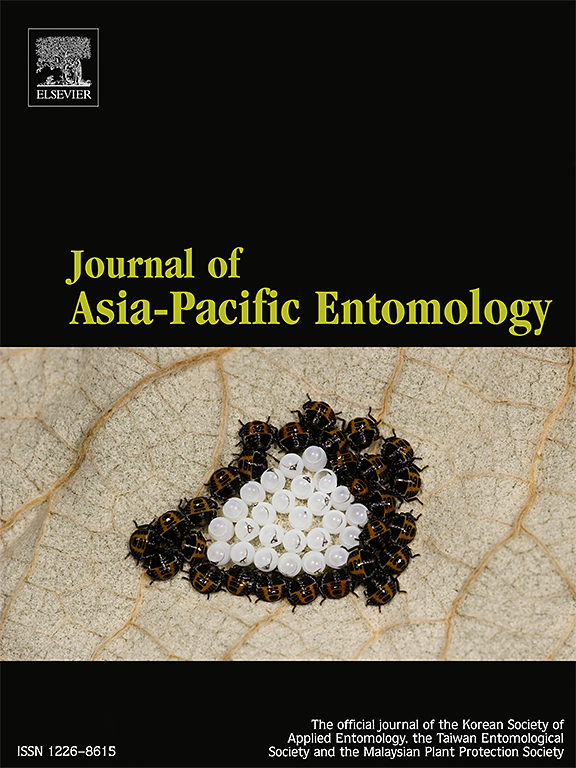Mode of action underlying toxicity of Camptothecin to Spodoptera frugiperda (Lepidoptera) larvae
IF 1.1
3区 农林科学
Q3 ENTOMOLOGY
引用次数: 0
Abstract
Camptothecin (CPT) is derived from Camptotheca acuminate and its main action is the inhibition of the DNA topoisomerase I (Top I) complex. Therefore, CPT and its derivatives are always used as antitumor and antimicrobial agents and also have some insecticidal effects. However, the mode of action underlying the toxicity of CPT to the virulence of pests is still not fully understood. In this study, the effects of CPT on Spodoptera frugiperda (S. frugiperda) were determined by performing toxicity assessments, metabolomics, and mechanism analysis. The results showed that CPT increased the efficiency of inhibition of larval weight in a dose and time-dependent manner. In addition, the metabolomics of 5th-instar larval hemolymph was determined by UPLC-MS/MS and 1H NMR analysis. UPLC-MS/MS analysis showed that the energy metabolic pathway was more important than the amino acid pathway for the resistance of S. frugiperda to CPT. Furthermore, metabolites involved in the energy metabolic pathway were analyzed using 1H NMR, and fumarate and pyruvate were identified as interesting metabolites. Bioassays confirmed that they play a key role in enhancing the resistance of S. frugiperda larvae to CPT. Finally, the underlying mechanisms were found to be related to the restorative effects of the two metabolites on metabolic pathways associated with the TCA cycle. In a word, CPT is a potential biological insecticide that exhibits a strong toxicological effect against S. frugiperda by inhibiting the TCA cycle, which provides theoretical support for applying CPT in the control of pests.

喜树碱对 Spodoptera frugiperda(鳞翅目)幼虫的毒性所依据的作用模式
喜树碱(CPT)来自于喜树的渐尖叶,其主要作用是抑制 DNA 拓扑异构酶 I(Top I)复合物。因此,喜树碱及其衍生物一直被用作抗肿瘤和抗菌剂,还具有一定的杀虫作用。然而,CPT 对害虫毒力产生毒性的作用模式尚未完全清楚。本研究通过毒性评估、代谢组学和机理分析,确定了 CPT 对鞘翅目蚜虫(S. frugiperda)的影响。结果表明,氯化石蜡对幼虫体重的抑制效率的提高与剂量和时间有关。此外,还通过 UPLC-MS/MS 和 1H NMR 分析测定了五龄幼虫血淋巴的代谢组学。UPLC-MS/MS分析表明,能量代谢途径比氨基酸途径对节肢动物对CPT的抗性更为重要。此外,还利用 1H NMR 分析了能量代谢途径中的代谢物,发现富马酸和丙酮酸是有趣的代谢物。生物测定证实,它们在增强节肢动物幼虫对 CPT 的抗性方面发挥了关键作用。最后,研究发现其基本机制与这两种代谢物对 TCA 循环相关代谢途径的恢复作用有关。总之,CPT 是一种潜在的生物杀虫剂,它通过抑制 TCA 循环对蚜虫表现出很强的毒性作用,这为应用 CPT 控制害虫提供了理论支持。
本文章由计算机程序翻译,如有差异,请以英文原文为准。
求助全文
约1分钟内获得全文
求助全文
来源期刊

Journal of Asia-pacific Entomology
Agricultural and Biological Sciences-Insect Science
CiteScore
2.70
自引率
6.70%
发文量
152
审稿时长
69 days
期刊介绍:
The journal publishes original research papers, review articles and short communications in the basic and applied area concerning insects, mites or other arthropods and nematodes of economic importance in agriculture, forestry, industry, human and animal health, and natural resource and environment management, and is the official journal of the Korean Society of Applied Entomology and the Taiwan Entomological Society.
文献相关原料
公司名称
产品信息
阿拉丁
acarbose hydrate
 求助内容:
求助内容: 应助结果提醒方式:
应助结果提醒方式:


